| Some activities may require making graphs on paper. Click here to view and print graph paper, as needed. |
|
|
| |
| |
| In the following problems, determine whether the function represents exponential growth or exponential decay by examining the multiplier. |
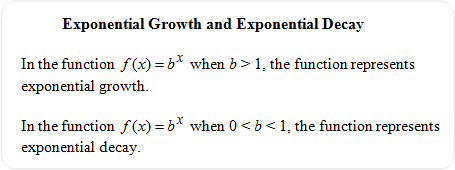 |
|
| |
| 1) The exponential function is what type? |
 |
|
|
| |
|
| 2) The exponential function is what type? |
 |
|
|
| |
|
| In the following problems, evaluate the expression to the nearest thousandth for the given value of x. |
|
|
| |
| |
|
| |
|
| |
|
| Graphing Exponential Functions |
|
|
| |
| In the next four questions, refer to the four graphs shown below. |
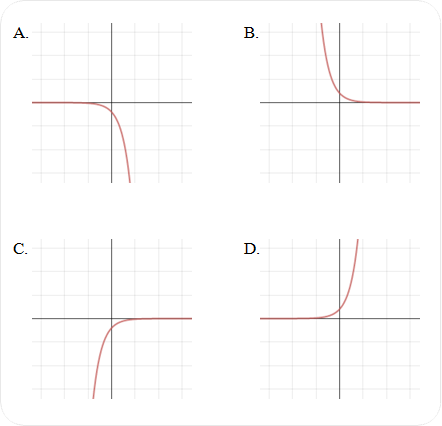 |
|
| |
6) Which graph matches the function?
Hint: Make a table of values. Choose x-values and substitute the values in the function and calculate y.
Click here to view the four choices. |
 |
|
|
| |
|
7) Which graph matches the function?
Click here to view the four choices. |
 |
|
|
| |
|
8) Which graph matches the function?
Click here to view the four choices. |
 |
|
|
| |
|
9) Which graph matches the function?
Click here to view the four choices. |
 |
|
|
| |
|
| 10) What is the x-intercept of the given function? |
 |
|
|
| |
|
In the following problems, determine the y-intercept.
Hint: Recall that the x-coordinate of the y-intercept is zero; thus, let x = 0 and solve. |
|
|
| |
| 11) What is the y-intercept of the given function? |
 |
|
|
| |
|
| 12) What is the y-intercept of the given function? |
 |
|
|
| |
|
13) Describe the range of the given function with the restrictions on the base (b).
Hint: Assign b any value between 0 and 1, and graph. Try a couple of different numbers and look for an overall pattern or trend in the range values. |
 |
|
|
| |
|
| Applications of Exponential Growth and Decay |
|
|
| |
| In the following problems, find the multiplier for the rate of exponential growth or decay. Express the multiplier as a decimal. |
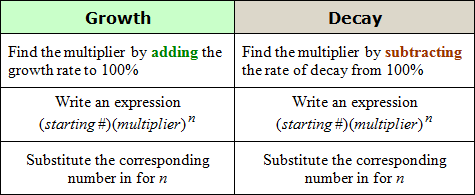 |
|
| |
| |
|
| |
|
| |
|
| |
|
| In the next group of problems, exponential growth and exponential decay will be applied to real world scenarios. Recall the basic formula: |
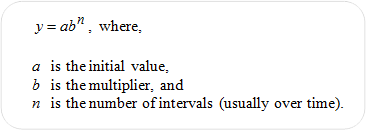 |
|
| |
| In the following problems, predict the population based on the following scenario: |
 |
|
| |
| |
|
| |
|
| |
|
| |
|
| In the following problems, calculate the final amount the investment will return through compound interest for the given terms. |
 |
|
| |
| |
|
| |
|
| |
| |
|
| |
|
| |
|
| |
|
28) Multiply the matrices.
Hint: Determine the dimensions of the product matrix, and then proceed to work row over each column.
Click here to review the unit content explanation for Matrices. |
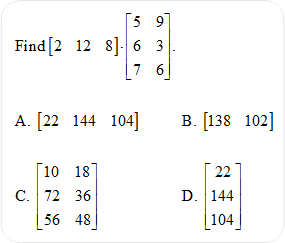 |
|
|
| |
|
29) Show that the given function is a quadratic function by writing it in the standard form.
Hint: Use the FOIL property to multiply the two binomials.
Click here to review the unit content explanation for Quadratic Functions. |
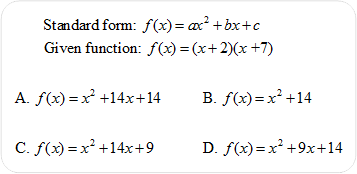 |
|
|
| |
|
30) Solve using the quadratic formula.
Hint: Put the quadratic equation in standard form, and then use the quadratic formula.
Click here to review the unit content explanation for Solving Quadratic Equations. |
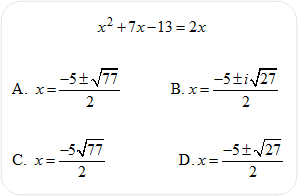 |
|
|
| |
|
| 31) If you were directed by your school to complete Offline Activities for this course, please enter the information on the Log Entry form. |
|
| No offline activities found |
0 Hour(s) & 0 Minute(s)
|
|
|
Attachments |
|